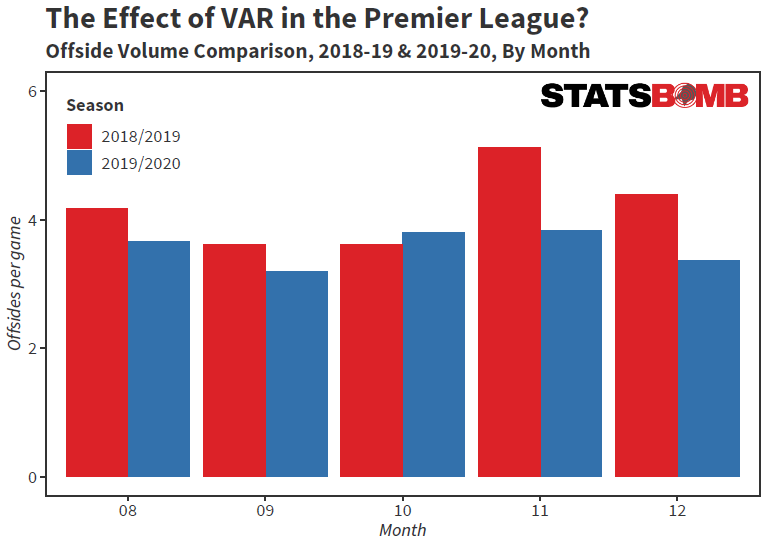Offside was supposed to be the easy part of VAR, they said. It’s a black and white decision, they said. Either he’s on or he’s off, they said. It’s perfect for technology, they said. They sure said a lot of stuff. Over the last week, Premier League watchers have been subjected to watching goals get ruled off after a long video replay delay when an armpit, or a toe, or a wisp of hair has been judged to have been ruled on the wrong side of a defender by mere centimeters. It’s worth prying apart exactly what is, and isn’t, going on, as the Premier League continues to try and implement the great VAR experiment.
First, let’s ground the discussion in what has (and hasn’t) changed. Surprisingly, there’s been remarkably little change in the actual things happening on the field. By almost any measure you can find, the game is basically being played pretty close to exactly the same way it was last season. Last year teams scored on average 1.37 goals per match (to be clear that’s per team, per match, the same way I’m going to list all the stats here), this season it’s 1.36 so far. Last season, on average, a team took 12.52 shots per match. This season it’s gone up a gigantic 0.03 shots per match to 12.55. If we’re desperate to pry things apart to find a change, the best we can do is look at clear shots (shots without a defender between the shooter and keeper) and find that while last season a team would on average take 2.20 per match, this season it’s down to 1.98.
Is that something? Is that evidence that with new VAR-driven offside rules players are no longer getting in behind as much, leading to almost half a shot (remember we’re looking at per game, per team, numbers here so that’s a 0.44 total per match, 0.22 for each team) less of good old defense-splitting, goal-scoring opportunities? Well, the shift in shooting numbers might be a thing, but it’s certainly not reflected in overall expected goal totals. So, probably not. Teams are averaging an almost identical non-penalty xG per match total of 1.25 this year, compared to 1.21 last season. Their xG per shot averages to 0.10 both seasons. Penalties, interestingly, are being awarded at ever so slightly lower rates with teams getting 0.11 per match this season, as compared to 0.14 per match last season (but really that’s a tiny tiny change to read anything into).
For all the noise surrounding VAR, the good news is it hasn’t, as yet, changed the overall nature of football in the Premier League at all. Many are concerned that VAR consistently awards tight offside decisions and negates goals, thus making it harder for strikers to get in behind, harder for teams to score, and in general decreasing attacking potency across the board. And there’s ample evidence that hasn’t happened.
For all that hasn’t changed, there is one fairly large difference in gameplay that has occurred from last season to this one. It’s definitely not one I expected to see though. There have actually been notably fewer offside decisions given this season than last. Weird, huh?

We can speculate about a number of reasons why this might be. I’d be being an irresponsible stats blogger if I didn’t start off saying natural variance could be the cause. Maybe the specter of VAR has changed how teams play, with strikers already reining in their runs lest they get penalized on replay. Or maybe this is a result of assistant referees being instructed to let the game run on close offside decisions in order to better utilize VAR and a number of those situations simply don’t result in goals, and thus are never examined. Whatever the reason, the actual stats are clear. In the era of VAR, there are actually significantly fewer whistles blown for offside than before.
Yet none of this should take away from the obvious impact that VAR has had on how fans experience the offside rule. In fact, it just makes answering the question harder. If fundamentally all that’s changed is that we have fewer offside whistled, then why does everything feel so much worse?
There are, I think, two interlocking issues here. There’s a technological one about the current system’s ability to actually generate the correct decision on close calls, and there’s the experience of the VAR decision itself.
Let’s take the second one first. Before VAR, there were plenty of close offside decisions given. Many were even wrong! But they were largely forgotten because, and I think this is crucial to the experience, they didn’t actually result in goals happening. The play would be blown dead, possession awarded the other way, and everybody would rightly go on with their lives. We didn't need to listen to 30 minutes of post-match talk shows host debating whether Jamie Vardy was a toenail offside on a random pass that might have set him free just before halftime because if the flag went up, that ended the move. There was literally nothing to see here.
Now, though, the experience is entirely different. Now, that decision is close, so the flag stays down until the end of the move, and if that pass results in a goal it’s reviewed either way. Even if the linesman would have flagged it last year, and he ultimately gives it this year, now it becomes a goal that’s chalked off due to VAR, while last season it was just one more close but unremarkable call. The entire top half of this article I talked about how the stats are unchanged. Well, that’s true, but part of that is because a goal like the hypothetical Vardy one I’ve painted, which gets ruled out for offside, doesn’t count in the stats. For stats purposes it didn’t happen. In terms of the game, it didn’t count. And yet, we all saw it.
Again, the important thing to emphasize about this hypothetical is that it’s a situation in which the call was the same before and after VAR. It’s a close offside call which, by the letter of the law, is correctly given in favor of the defense. Without VAR, it’s an entirely forgettable moment, with VAR it’s a goal that’s ruled out and a contentious talking point. Is that a good thing? It certainly isn’t on its own, but you could at least make the argument that it’s a worthwhile price for getting the increased accuracy that VAR provides.
Which brings us to the technological limitations. Exactly how accurate is the VAR camera system at detecting an offside infraction anyway? As Jonathan Wilson has covered, not as incredibly precise as we’d hope. The issue has to do with frame rates and pinpointing exactly when the ball leaves the foot of the passer. It’s important not to overstate the impact of uncertainty, and in reality, though the issue of camera frame rates not being fast enough to be entirely precise on the closest of calls is real, it also has an extremely marginal effect. But, regardless, it would be a fairly straightforward fix to introduce a margin of error into the system and only overrule calls that were outside the margin of error.
That would fix the particulars of the accuracy problem, but would only serve to knock the argument down the line. Instead of arguing about whether or not the reviewed call was correctly upheld or overturned, the argument would shift to whether or not the call fell within the bounds of being reviewable. You can’t actually technologize or rule write your way out of the reality that close calls exist. Wherever you draw the offside line, or the video reviewability cut-off point, there will always be calls that narrowly fall on one side or the other of that line.
The other option, if you really don’t like close decisions being decided either by humans or cameras based on incredibly fine margins, would be to dramatically change the offside rule and insist that the spirit of the rule, “gaining an unfair advantage,” be how an infraction is judged. If you think moving from the relatively objective standard of a line to a subjective judgment will make things less controversial . . . well, let me introduce you to the handball rule.
Ultimately, the technology is the easy part. It’s not only possible, but quite likely that the game can successfully calibrate its systems, it can account for the fact that at the closest of margins some things are fundamentally unknowable. Whether that accuracy is worth the price is another question. In order to get it right, the system has to elevate a small percentage of extremely marginal calls from obscurity to center stage. These are the kinds of calls that are the hardest to get right and the most controversial even when they’re correct. Without VAR they go largely unnoticed, even when they’re wrong. Now, thanks to the system, they’re in the spotlight. The process of being more accurate by definition shows us all what might have been, and then takes it away thanks to decisions that are juuuuuust this side of arbitrary. So, when judging VAR and offside, the only question that matters is, is it worth it?
